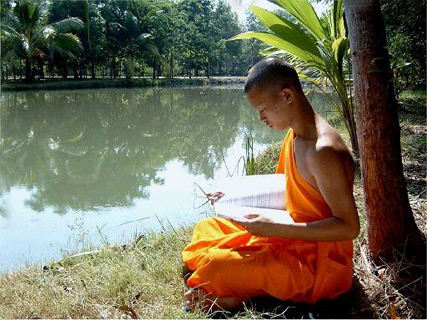|
|

|
Love for others and respect for their rights and dignity, no matter who or what they are: ultimately these are all we need. So long as we practice these in our daily lives, then no matter if we are learned or unlearned, whether we believe in Buddha or God, or follow some other religion or none at all, as long as we have compassion for others and conduct ourselves with restraint out of a sense of responsibility, there is no doubt we will be happy.
The Fourteenth Dalai Lama
|
World Religions
Teaching a course on the word's religions has never been so vitally important. The role of religion in the world today, as well as its central place in the lives of traditional societies throughout history, makes an understanding of religious history and beliefs of great value in understanding the world. My goal in teaching World Religions has been to present the world's faiths in a way that emphasizes religion at its best, exploring the various ways that faith traditions have attempted to address the great questions of humankind.
|
 |
 |
Though the unit presented here assumes its form on the Internet through the auspices of a National Endowment for the Humanities Institute on the Cultures and Religions of the Himalayan Region, it presents curriculum materials on Buddhism in general, and is not a specialized exploration of Buddhism in the Himalayas (though Tibet is certainly represented). The overall goal of the unit is to present the origins and basic beliefs of Buddhism, as well as to explore the various forms that it takes in the world today. Like all faith traditions, Buddhism represents not a single monolithic religion, but rather a diverse collection of practices, beliefs, and rituals. |
For each section of my Buddhism unit, you will find questions for discussion, appropriate for the texts that I use (see "General Course Information") along with a variety of other curriculum materials. I have drawn on a variety of sources available to teachers, along with presenting some tried and true activities that I have used in my own course. Many people are responsible for the materials you find here. I wish to thank all my students, as well as my colleagues at the NEH Institute and its leaders, Professors Todd Lewis of Holy Cross and Leonard van der Kuijp of Harvard. It is with great enthusiasm that I present these curriculum materials for you to share.
Jim Blynt, July 2006
|
 |
Essential Questions of the Course:
- What do the world’s religions tell us about ultimate reality and the meaning of existence?
- How do the world’s religions address the basic questions of the human race: Where are we? Why are we here? What does it all mean? What are we supposed to do?
- In what way are the world’s religions similar and different?
- How are the world's religions representative of the great diversity of human society?
|
|

